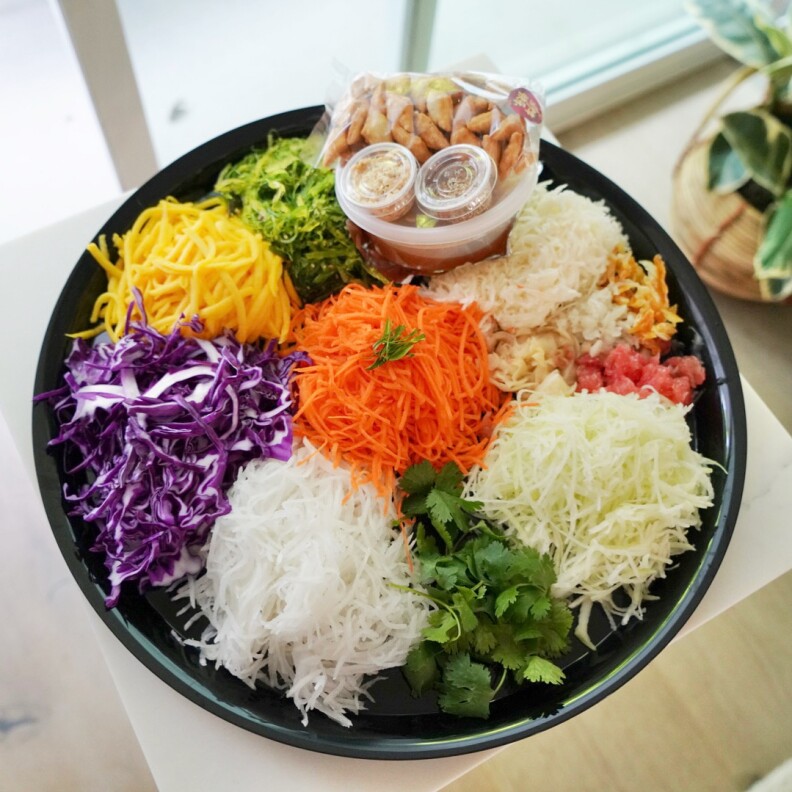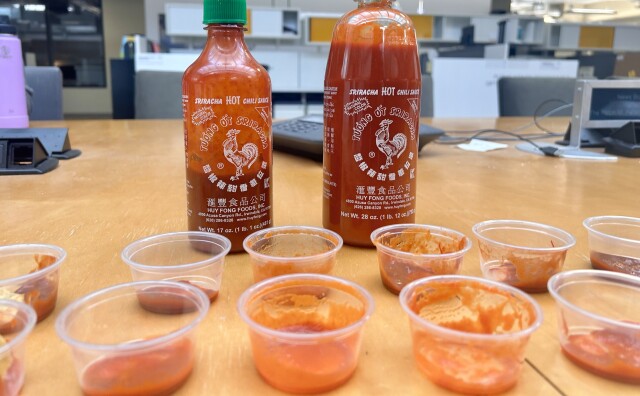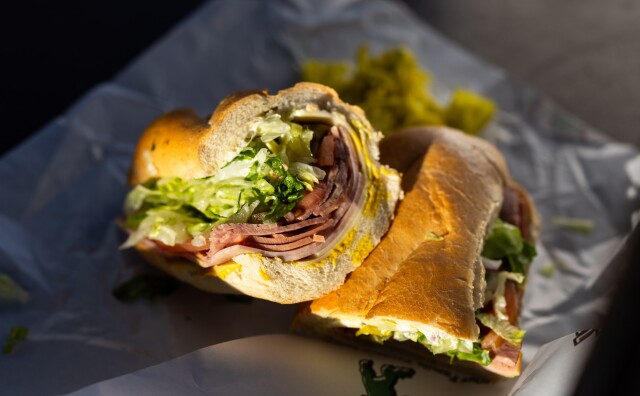Lunar New Year Starts This Weekend. Here's How To Celebrate The Year Of The Dragon In LA

- What is Lunar New Year?
- Chinese New Year
- Whole fish
- Poon choi
- Tray of togetherness
- Nián gāo
- Jiaozi
- Lo hei or yusheng
- Seollal
- Tteokguk
- Jeon
- Tết Nguyên Đán
- Bánh tét or bánh chưng
- Mut tet
- Splurge-worthy meals
- Celebrations in Los Angeles
- Golden Dragon Lunar New Year Parade
- UVSA Tết Festival
- Lunar New Year at Pacific Asia Museum
- Lunar New Year at South Coast Botanic Garden
- Chinese New Year Festival at The Huntington
- MAUM Market
What is Lunar New Year?
Saturday, Feb. 10, marks the Lunar New Year, welcoming the Chinese zodiac Year of the Dragon. This celebration is observed by millions worldwide, including China, Vietnam, Korea, and, of course, connected communities in Los Angeles.
Each community celebrates the festival differently, with different food traditions. We’ve pulled together some culinary offerings around L.A. this year.
Chinese New Year
Chinese New Year activities typically start with some thorough house cleaning before the new year itself. Homes are decorated in red for good luck. The foods traditionally eaten for Chinese New Year are symbolic of longevity and prosperity in some way, usually because of the shape or because the names of the dishes are homophones for related words.
Here are some of the foods typically eaten on Chinese New Year:
Whole fish
The word for fish in Mandarin, yú, is a homophone for another word that means “abundance” or “surplus” — hence, eating fish on Chinese New Year is considered lucky and will bring abundance in the new year. The fish is usually served whole and reflects completion from the beginning to the end, but this is not always the case, especially for smaller households.

Some of the fish specials you can find around town this year include:
- Bistro Na’s is offering different Lunar New Year sets that serve 6-10 people, and all of them include at least one fish dish.
- Crustacean Beverly Hills is offering a $188 eight-course (because eight is an auspicious number) dinner extravaganza with crispy dover sole, black truffle turnip cakes, and more. The dining room will be decked out in Lunar New Year decorations and there will be live entertainers throughout the night.
- Paradise Dynasty is offering some special dishes like Singapore-style black pepper lobster. There will also be a steamed Chilean sea bass and eight treasure sticky rice for dessert, another popular Lunar New Year treat. The special dishes are available now through March 31, 2024.
- Steep will have a collaboration dinner with Chef Anthony Wang on Feb. 9-10. There will be an eight-course menu featuring steamed rockfish, radish cake with XO sauce, braised pork belly with abalone, and more.
Poon choi

This traditional Cantonese meal translates to “basin vegetables” and is served in a large basin. It’s not all vegetables, though — the Lunar New Year poon choi usually also contains several luxurious ingredients like abalone, sea cucumber, BBQ and more.
Poon choi has become a popular Lunar New Year dish in Los Angeles over the past couple of years, with many restaurants offering it at this time of year.
Order the dish from Hop Woo BBQ & Seafood Restaurant, Capital Seafood, Ho Kee Cafe, Sea Harbour, and many others. Colette in Pasadena will also offer poon choi by pre-order this year, and there are two sizes available: one that feeds six and a larger one for ten people.
Tray of togetherness
The tray of togetherness is a tray filled with sweets with symbolic meanings that are served to guests. The tray usually has six or eight compartments with various sweets including candied lotus roots, which symbolize abundance, candied coconut, which symbolizes togetherness, and candied lotus seeds for fertility.
Different versions of the tray can be found at Asian grocery stores such as 99 Ranch Market and 168 Market.
Nián gāo
This dense, glutinous rice cake is another traditional symbolic food. The name, nián gāo, sounds similar to words that mean “getting higher every year” and thus symbolizes growth and progress. While there is both a sweet and savory version, the sweet version is more popular, made with glutinous rice flour and sweetened with brown sugar (some versions may also use chestnuts or red beans). In L.A., you can get them at:
- Kee Wah Bakery. In addition to the rice cake, the bakery also has an assortment of gift sets in Chinese New Year packaging.
- Woon, which is serving Chinese New Year specials from Feb. 7-11, including savory, stir-fried nián gāo. Woon will also turn up the festivities with red envelope roulette with prizes like t-shirts and free noodles.
Jiaozi
Jiaozi is the crescent-shaped dumplings that you may know as potstickers. Although dumplings in general are commonly found at celebrations, jiaozi is typically eaten during Chinese New Year as an auspicious food, since the shape of the dumplings resemble the gold ingots or sycee used as currency in imperial China.

You can find jiaozi or potstickers at many restaurants around L.A., including:
- Din Tai Fung, which also serves crescent shaped dumplings in addition to their famous xiao long bao. From Feb. 8-12, Din Tai Fung will be giving guests a red envelope containing a certificate for a free soy noodle appetizer (to be used for a future visit). One lucky guest will get a Golden Ticket, allowing access to the restaurant’s VIP reservation service, which pretty much guarantees you can always get a reservation.
Lo hei or yusheng

Even within Chinese New Year celebrations, there are quite a few regional variations. For example, the Cantonese lo hei — also called yusheng, or “prosperity toss” — is a raw fish salad that is “tossed” on Chinese New Year and symbolizes abundance. Yusheng is popular among the Chinese communities in Singapore and Malaysia.
Here in L.A., you can pre-order it at:
- Malaysianfoodloversla, which sells them via Instagram for pickup in Arcadia. They’re offering three different seafood toppings: fried shrimp, cocktail shrimp or arctic surf clam.
- Ms. Chi Cafe, in Culver City, will be offering a special six-course Lunar New Year menu that includes a yusheng salad, followed by golden chicken jiaozi symbolizing wealth, longevity noodles with spicy garlic prawns, Chilean sea bass and more. The $69 menu will be served at dinner from Feb. 9-25.
- Home chef Sam Tan’s Kitchen will have lo hei available for pick up from Feb. 3-24.
Seollal
In Korean, Lunar New Year is called seollal and it’s typically celebrated over three days. Some traditions are similar to those of Chinese New Year, where people travel to their family homes, perform an ancestral ritual, and young ones bow to the elders to show respect and receive money in a red (or white) packet.
Tteokguk
The main dish eaten for seollal is tteokguk, a rice cake soup traditionally made with beef bone broth. The dish is believed to grant good luck and it’s said that people don’t gain another year of age until they’ve had their bowl of tteokguk. The white of the rice cakes also symbolize purity and a bright new beginning.
- Find tteokguk at Hangari Kalguksu, Ma Dang Gook Soo, Sun Nong Dan and other places in Koreatown.
- Baekjeong KBBQ and Ahgassi Gopchang will both be serving a complimentary bowl of tteokguk for all guests during lunch and dinner service on February 10.
- Instead of tteokguk, Yangban Society will be gungjung tteokbokki, or “royal rice cake”. In this royal court version, the rice cakes will be served with braised oxtail, hobak squash, shiitake and preserved black truffles. The gungjung tteokbokki will be available Feb. 9-11.
Jeon
The savory pancakes, jeon, aren’t necessarily a seollal-specific dish, but they make an appearance at all celebrations in Korea, including seollal. Jeon can be made from various vegetables and sometimes also incorporate meat or seafood.
- HanEuem in Koreatown serves a platter of different varieties of jeon.
- Baroo is serving a special seven-course dinner on Feb. 10 which will include a seafood jeon with shrimp and sea cucumber as well as maesaengi tteokguk (rice cake soup with seaweed oyster broth). Book it here.
Tết Nguyên Đán
The Lunar New Year celebration in Vietnam is called Tết Nguyên Đán, or Tết for short, and it means “feast for the first morning” — so you know this new year celebration is all about the food.
Bánh tét or bánh chưng
A must-have for a Vietnamese Lunar New Year celebration is bánh tét or bánh chưng. They are glutinous rice cakes wrapped in a banana leaf and typically filled with mung beans and marinated pork. While bánh tét is cylindrical in shape and popular in South Vietnam, bánh chưng is square in shape and eaten more in the northern parts of Vietnam.
The dish is time-consuming to make, and that’s part of its importance, as families spend time together and bond while making it. Around Lunar New Year every year, Bánh Chưng Collective holds a bánh chưng making class. This year’s class will be on Feb. 17, 2024 and attendees will get enough ingredients to make four bánh chưng and everyone will enjoy lunch together (the bánh chưng are taken home to be cooked later).
If you want to enjoy it without making it yourself, though, there are quite a few places to get them in the L.A. area, since bánh tét / bánh chưng are actually eaten year-round. You can find them at various Vietnamese bakeries and delis. Around Tết you can also get some at Sau Can Tho or order them from Kien Gang Bakery while supplies last.
Mut tet
Similar to the Chinese New Year tradition of the tray of togetherness, Vietnamese New Year also has a tray of sweets called mut tet that is used to serve guests during Lunar New Year. Some of the components are also the same, like candied coconut or lotus seeds, but you’d also typically find candied tamarind. You can buy these trays at Vietnamese grocery stores around San Gabriel Valley or Little Saigon.
Splurge-worthy meals
All the auspicious foods listed above are important traditions for many, but really, the most important thing is sharing good food with your loved ones. For many it’s also the time of year to splurge on a dinner too expensive for the day-to-day. There are a number of special dinners happening around town that aren’t about the specific food items, but that are worth looking into:
- Michelin-starred Kato will have their third Lunar New Year dinner series on Feb. 7-9, serving a special menu in collaboration with chefs Daisy Ryan (Bell’s) and Matthew Lightner (okta). The menu hasn’t been finalized yet but reservations can be made here.
- The high end yakiniku restaurant Niku X will offer a special Lunar New Year tasting menu from Feb. 9-11. The menu costs $250 per person and includes wagyu oxtail potstickers, dry aged sashimi, caviar, and of course, plenty of A5 wagyu for the grill.
- Merois at The Pendry West Hollywood is also offering a special four-course menu on Feb. 10. The menu costs $165 per person and includes Peking duck, king crab bao and more. There will also be live entertainment throughout the night.
Celebrations in Los Angeles
Aside from the food specials we mentioned above, there are also a number of larger community celebrations of Lunar New Year around the Los Angeles area. At these celebrations you’ll find dance performances, cultural showcases, and of course — more food.
Golden Dragon Lunar New Year Parade
The Chinese Chamber of Commerce of Los Angeles is hosting the 125th annual Golden Dragon Parade on Saturday, Feb. 17. The parade is one of the oldest cultural celebrations in Los Angeles, and certainly one of the oldest Lunar New Year celebrations in the city as well. There will be dance performances and marching bands. The parade will start at the corner of Hill and Ord streets in Chinatown.
UVSA Tết Festival
The UVSA Tết Festival is the largest Vietnamese Lunar New Year Festival in the country and this year it will be held at the OC Fair & Event Center from Feb. 9-11. It's hosted by the Southern California chapter of UVSA, or Union of Vietnamese Student Associations. During the three-day festival, there will be cultural activities, food vendors, firecracker shows and more. There will also be a replica of a traditional Vietnamese village complete with cultural exhibits and galleries for those who want to learn more about Vietnamese culture.
Lunar New Year at Pacific Asia Museum
The USC Pacific Asia Museum in Pasadena will be throwing a Lunar New Year celebration on Saturday, Feb, 10. There will be a traditional Chinese lion dance performance as well as a Korean dance performance, taiko drumming, calligraphy and more. Those attending the celebration will also get free admission to the museum.
Lunar New Year at South Coast Botanic Garden
South Coast Botanic Garden will be celebrating Lunar New Year every weekend in February. On Saturdays and Sundays there will be two daily live performances of lion dancers, martial arts and more. There will also be various activity stations from 10 a.m. to 4 p.m., including lantern making, calligraphy and mahjong.
Chinese New Year Festival at The Huntington
On Feb. 10-11 The Huntington Library, Art Museum and Botanical Gardens will have a Chinese New Year Celebration. Not only will there be lion dancers and martial arts performances among other entertainment, the various dining venues here will have special menus, serving steamed buns, Chinese mushroom and tofu soup, black bean catfish, Peking duck and more. Reservations are required and can be made here.
MAUM Market
Lunar New Year seems like the perfect time to shop AAPI-owned businesses, and MAUM Market which is LA’s original Asian makers’ market will be holding a market on Saturday, Feb. 10 at ROW DTLA. There will be over 100 Asian-American makers showcasing everything from pottery to cute stationery to food. The market will be held from 12-4 p.m. and entry is free (there’s a free 2-hour parking at ROW DTLA).
-
“It was a downer,” said Agustin Ruelas, the co-owner at Brewjeria, the Latino and POC-owned craft brewery in Pico Rivera. “We just wanted to honor Selena.”
-
After people began complaining online that Sriracha they'd bought recently didn't taste like the old stuff, we set out to find the answer. It didn't go well.
-
From tortas to tuna melts, all sandwiches tell a unique story as they celebrate Los Angeles' diverse tapestry of flavors with each bite.
-
The company behind Sriracha told us production has resumed.
-
Dustin Bartz has figured out a way to sell a $6 smashburger — and still make a tidy profit. He enjoys trolling competitors who charge more.
-
Two amateur bakers take on a beloved, almost sacrosanct school treasure.









